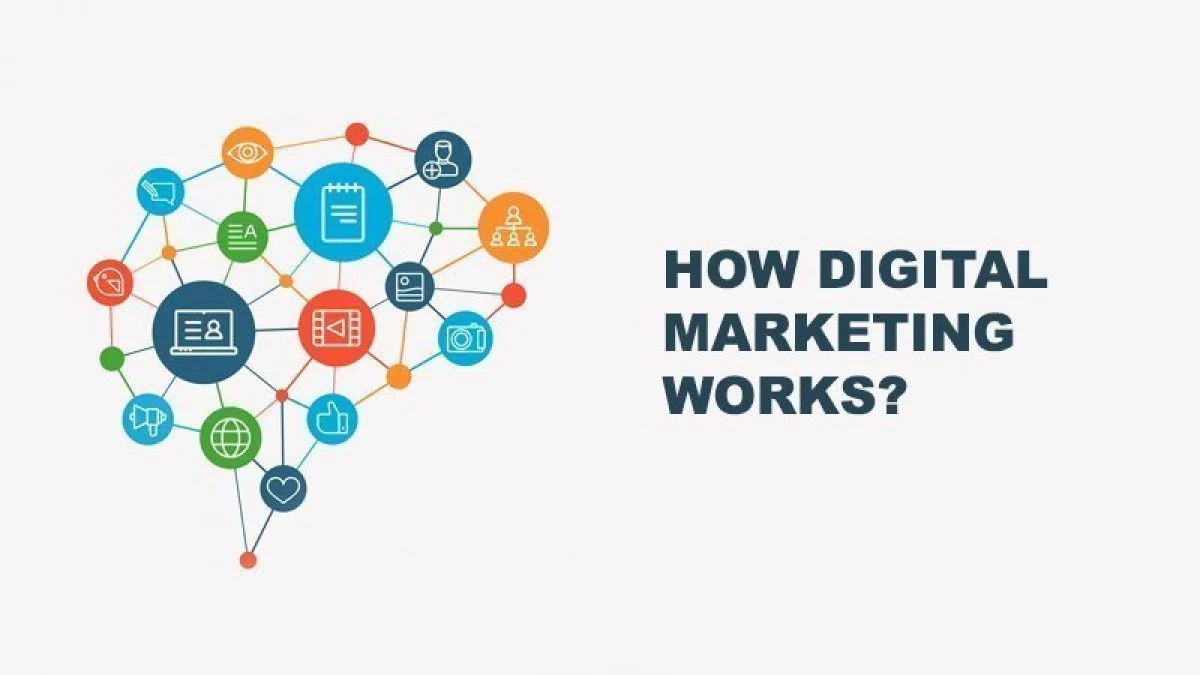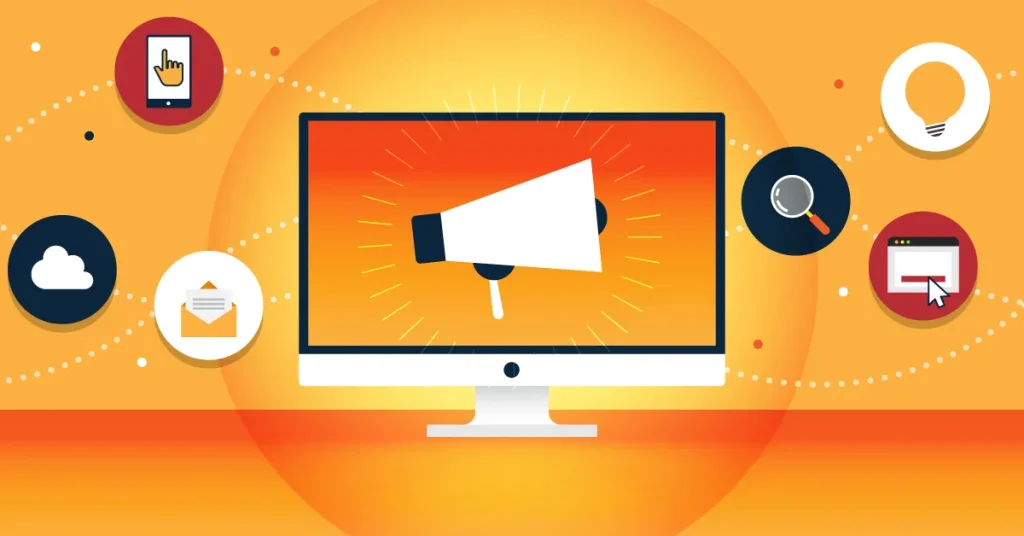Digital marketing refers to promoting products or services through digital channels like websites, social media, emails, and search engines. In today’s business landscape, it’s crucial because it allows businesses to reach a vast online audience where potential customers spend much of their time. Unlike traditional methods, digital marketing offers precise targeting, meaning ads can be tailored to specific demographics, interests, and behaviour. This precision leads to higher engagement and conversion rates.
It provides real-time analytics, allowing businesses to track the performance of their campaigns instantly. With the rise of e-commerce and online interactions, digital marketing has become essential for businesses of all sizes to stay competitive and connect with their target markets effectively. Its cost-effectiveness and ability to generate measurable results make it a cornerstone of modern marketing strategies.
Table of Contents
Key Components of Digital Marketing
The key components of digital marketing encompass a range of strategies and tactics that businesses use to reach and engage their target audience online.
- Search Engine Optimization (SEO): SEO involves optimizing a website to rank higher in search engine results pages (SERPs). This includes keyword research, content optimization, link building, and technical optimizations. The goal is to improve visibility and organic traffic.
- Pay-Per-Click (PPC) Advertising: PPC ads are paid advertisements that appear on search engines and other platforms. Advertisers pay a fee each time their ad is clicked. Platforms like Google Ads and social media ads (e.g., Facebook Ads) use this model.
- Social Media Marketing: This involves using social media platforms (such as Facebook, Instagram, Twitter, LinkedIn) to connect with the target audience. It includes organic posting, paid advertising, influencer collaborations, and community engagement.
- Email Marketing: Email campaigns involve sending targeted messages to a subscriber list. This can include newsletters, promotions, product updates, and personalized content. Email marketing aims to nurture leads, retain customers, and drive conversions.
- Content Marketing: Content marketing focuses on creating and distributing valuable, relevant, and consistent content to attract and retain a clearly defined audience. Content types include blog posts, videos, infographics, ebooks, and more.
- Influencer Marketing: Collaborating with influencers who have a dedicated following to promote products or services. This leverages the influencer’s credibility and reach to expand brand awareness and engagement.
How Digital Marketing Works
Digital marketing works by using the internet to reach people and promote businesses. First, companies learn about their customers’ journey, from when they first hear about a product to when they decide to buy it. Then, they use different online tools to target the right people.
One way is through SEO, which helps websites show up when someone searches for something online. So if you’re looking for “best coffee shops,” the ones with good SEO will pop up first. There’s also PPC, where businesses pay to show ads when people search for certain words. They only pay when someone clicks on their ad.
Social media is a big part too. Businesses use platforms like Facebook and Instagram to talk to customers, share cool stuff, and run ads. Email marketing sends messages directly to people’s inboxes, like newsletters or promotions. And influencers, who have lots of followers, can help spread the word about products.
All these tools help companies connect with customers online, show up when people are looking for them, and make sure their messages reach the right people. By using data to see what’s working, they can improve their strategies and keep growing online.
Benefits of Digital Marketing
Digital marketing offers many benefits for businesses looking to reach and engage their target audience online.
- Digital marketing allows businesses to reach a global audience 24/7. With the internet, businesses can connect with people anywhere, anytime, breaking the barriers of distance and time zones.
- Compared to traditional marketing methods like TV ads or billboards, digital marketing is often more affordable. Businesses can reach a larger audience with a smaller budget through tactics like social media ads or email campaigns.
- One of the significant advantages is the ability to measure the success of campaigns in real-time. Tools like Google Analytics provide detailed insights into website traffic, conversions, and engagement, allowing businesses to adjust strategies for better results.
- Digital marketing enables precise targeting based on demographics, interests, behaviors, and more. This means ads are shown to people who are more likely to be interested in the products or services, increasing the chances of conversion.
- Social media platforms and content marketing encourage two-way communication between businesses and customers. This engagement builds relationships, brand loyalty, and trust over time.
- Digital marketing campaigns can be quickly adjusted and optimized based on performance data. If something isn’t working, changes can be made swiftly, allowing businesses to stay agile in a dynamic online landscape.
- Through consistent and strategic digital marketing efforts, businesses can establish a strong online presence and build brand awareness. Quality content, social media interactions, and positive reviews contribute to a positive brand image.
- Digital marketing can complement traditional marketing methods, providing a comprehensive approach. For example, a TV ad can prompt viewers to visit a website or engage on social media for more information.
Challenges and Considerations
While digital marketing offers numerous advantages, it also comes with its set of challenges and considerations that businesses.
- Rapid Technological Changes: The digital landscape evolves quickly with new platforms, algorithms, and trends. Staying updated and adapting to these changes can be challenging, requiring ongoing learning and flexibility.
- Competition and Saturation: The online space is crowded with businesses vying for attention. Standing out among competitors requires creativity, unique branding, and compelling content to capture the audience’s interest.
- Privacy and Data Security: With the collection of customer data for targeting, businesses must prioritize data protection and privacy compliance. Mishandling data can lead to legal issues and damage to brand reputation.
- Ad Fatigue and Banner Blindness: Consumers are inundated with ads online, leading to ad fatigue and banner blindness. This means people may ignore or actively avoid ads, making it harder for businesses to grab attention.
- Content Quality and Engagement: With the vast amount of content available, ensuring quality and engaging content is crucial. Businesses must consistently produce valuable content that resonates with their audience to maintain interest and trust.
- Measurement and Attribution: While digital marketing offers detailed analytics, attributing conversions to specific channels can be complex. Understanding which channels are driving results and allocating resources effectively requires careful analysis.
- Technical Challenges: Managing various digital marketing tools and platforms can be daunting, especially for small businesses with limited resources. Technical issues such as website maintenance, SEO, and email deliverability need attention.
- Negative Feedback and Reviews: In the digital space, negative feedback and reviews can spread quickly and harm reputation. Businesses must have strategies in place to address and manage such situations promptly and professionally.
- Cultural and Language Barriers: In global digital marketing campaigns, businesses encounter cultural and language barriers. Understanding diverse audiences and adapting content accordingly is crucial for successful international campaigns.
- Balance with Traditional Marketing: Finding the right balance between digital and traditional marketing can be tricky. Each has its strengths, and businesses must strategize to maximize the benefits of both while avoiding overlap or inefficiencies.
Conclusion
Digital marketing is a must-have for businesses today. It helps them connect with people worldwide, using tools like SEO and social media to get their message out. The perks are clear: it’s cheaper, reaches the right people, and gives instant feedback through analytics.
But there are challenges too, like keeping up with fast changes in tech, standing out in a crowded online space, and protecting customer data. Still, by learning and adapting, businesses can make the most of digital marketing. As we move ahead, it’ll keep evolving with new tech and customer habits.







